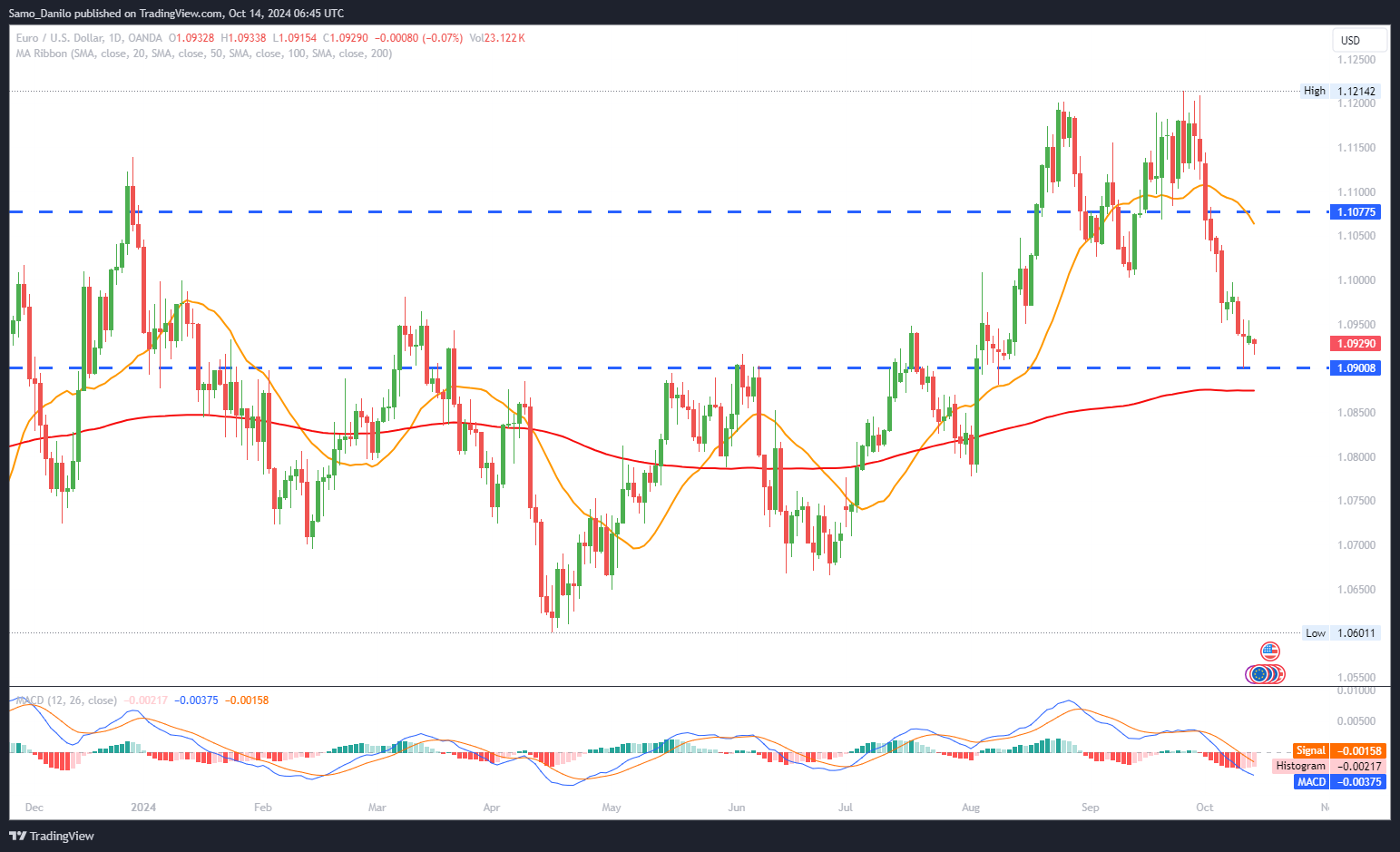EURUSD
- Extended Decline: EUR/USD continues its downward trend, trading near 1.0920 early Monday, marking its fourth consecutive day in negative territory.
- Fed Rate Cut Expectations: Traders are pricing in a 25-basis points rate cut from the Federal Reserve in November, supported by the US Producer Price Index (PPI) data, which showed a 1.8% annual increase in September, slightly above market expectations.
- US-Taiwan Tensions: Geopolitical concerns arose after a US Department of State spokesperson expressed serious concern over military drills by the People's Liberation Army (PLA) in the Taiwan Strait, adding to global risk aversion.
- ECB Rate Cut Pressure: The Euro remains under pressure as expectations grow that the European Central Bank (ECB) will cut interest rates in its remaining two monetary policy meetings this year due to slowing economic conditions.
Closing statement: EUR/USD could remain vulnerable as the divergence between the Fed and ECB policy paths persists. Escalating geopolitical tensions and further economic data will drive market sentiment.
GBPUSD
- Struggles to Build on Gains: GBP/USD faces selling pressure at the start of the new week, unable to extend Friday's modest gains.
- BoE Rate Cut Expectations: The British Pound is weighed down by growing expectations that the Bank of England (BoE) may accelerate its rate-cutting cycle, as hinted by BoE Governor Andrew Bailey. He noted the potential for more aggressive rate cuts if inflation continues to show improvement.
- UK Economic Growth: The UK Office for National Statistics (ONS) reported a 0.2% economic growth in August, signalling a modest recovery after stagnation in June and July.
- US Data Influence: From the US, the Producer Price Index (PPI) for final demand remained unchanged in September, with a 1.8% annual rise, maintaining support for the US Dollar.
| SMA (20) | Slightly Rising |
| |
| RSI (14) | Falling |
|
|
| MACD (12, 26, 9) | Falling |
|
|
Closing statement: GBP/USD is likely to remain under pressure as BoE dovish signals persist, while stable US data continues to favour the US Dollar. Further UK and US economic releases will shape the next move for the pair.
GOLD
- Gold Slips Back: Gold prices are still in the green early Monday, continuing gains made late last week as market sentiment shifts.
- Stronger US Dollar: The US Dollar strengthens, benefiting from a negative shift in risk sentiment, which is putting pressure on gold as investors seek safety in the USD.
- China Stimulus: China's Finance Minister reiterated plans to revive the economy but provided no specifics, leaving markets uncertain about future stimulus and its impact on demand for gold.
- Geopolitical Tensions: Escalating tensions between Israel and Iran, as well as between China and Taiwan, are concerning investors, yet they prefer the safe haven of the USD over gold.
- Holiday Trading: With US markets observing Columbus Day, the broader market sentiment and USD dynamics will dictate gold’s movement.
| SMA (20) | Rising |
|
|
| RSI (14) | Rising |
|
|
| MACD (12, 26, 9) | Rising |
|
|
Closing statement: Gold remains vulnerable to USD strength and market risk sentiment, with geopolitical concerns adding some uncertainty. Traders should watch for any major developments or shifts in risk appetite to determine gold's next direction.
CRUDE OIL
- WTI Extends Losses: West Texas Intermediate (WTI) crude oil prices continue their decline for a second session, trading around $74.60 per barrel on Monday.
- Chinese Inflation Data: WTI fell over 1% following lower-than-expected September Consumer Price Index (CPI) data from China. Consumer inflation unexpectedly eased, and producer inflation marked nearly two years of contraction, signaling weaker demand prospects from the world's largest oil importer.
- US Sanctions on Iran: The US expanded sanctions against Iran's petroleum and petrochemical sectors in response to an Iranian missile attack on Israel, heightening geopolitical risks that may influence future oil supply.
- Geopolitical Tensions: Hezbollah claimed responsibility for a drone attack in Israel, escalating Middle East tensions. This conflict could create further uncertainty in the oil market, with potential supply disruptions looming.
| SMA (20) | Slightly Rising |
| |
| RSI (14) | Rising |
|
|
| MACD (12, 26, 9) | Rising |
|
|
Closing statement: WTI crude remains pressured by weak Chinese inflation data, though geopolitical risks in the Middle East could provide a potential floor for oil prices in the short term. Market participants should monitor further developments for clearer direction.
DAX
- Key Stock Performers: Airbus Group and Siemens Energy AG saw significant gains, rallying 3.93% and 3.29%, respectively, driven by optimism around ECB and Fed rate paths. Tech stocks like SAP and Infineon Technologies also performed well. However, auto stocks experienced a mixed session, with BMW sliding 1.12% and Volkswagen down by 0.52%.
- German Inflation Decline: Germany’s annual inflation rate fell from 1.9% in August to 1.6% in September. This decline has fueled expectations of a 25-basis point rate cut by the European Central Bank (ECB) in October, influencing sentiment in the DAX market.
- ECB and Fed Focus: Investors are closely tracking ECB policymaker speeches on Monday, with a focus on their views regarding inflation, the economic outlook, and the central bank's interest rate trajectory.
- US PPI: In the US, September’s producer prices stagnated, signaling weaker demand and potentially softer consumer prices, which could influence the Federal Reserve's next move.
- Upcoming Events: FOMC member speeches on Monday will be closely watched for insights into the US labor market, inflation trends, and the Fed's rate policy, which could further impact buyer sentiment in DAX-listed stocks.
| SMA (20) | Rising |
|
|
| RSI (14) | Rising |
|
|
| MACD (12, 26, 9) | Rising |
|
|
Closing statement: DAX's outlook remains influenced by central bank rate expectations and inflation trends in both Europe and the US. Investors should monitor upcoming speeches and data for further directional cues.




